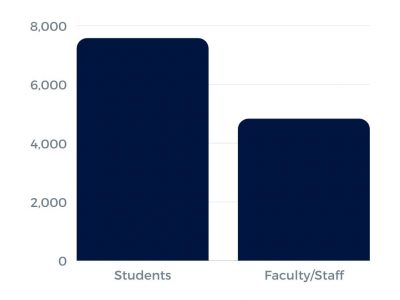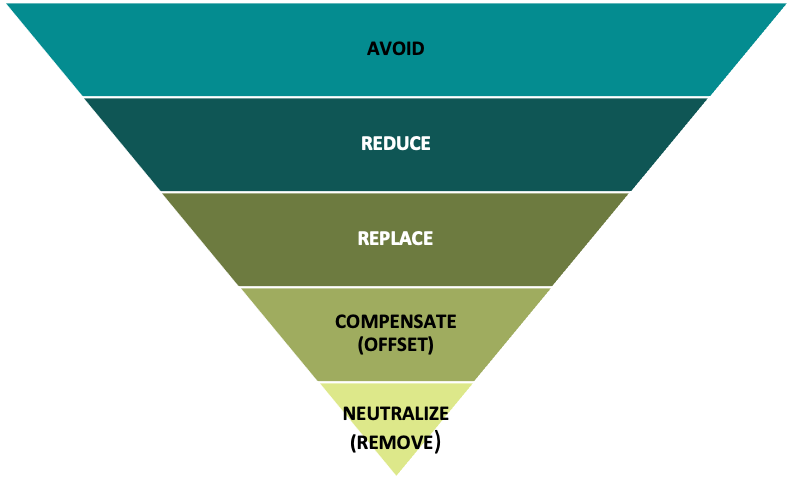Staff and student personal vehicle commuting at UConn contributes over 13,000 metric tons of carbon dioxide into the atmosphere every year. That contributes to approximately 12% of UConn's annual carbon footprint, and is equivalent to burning 1.5 million gallons of gasoline. Historically, UConn has very limited influence over this significant portion of its carbon footprint because it doesn’t own or choose the cars that employees and students drive. Now we’re offering an option for commuters to offset their commute’s carbon emissions. Anyone who chooses to participate can enroll in the Carbon Neutral Commuter Program (CNCP) after purchasing their parking pass.
What Is It?
A voluntary annual donation of $5 (or more if you'd like!) that goes towards projects that effectively prevent carbon emissions from being released into the atmosphere. These carbon negative projects work to offset the carbon emissions created by employees and students through their commute to campus.
How Do I Participate?
You can become a member at any point by making a donation on this page! We recommend making your donation annually right after you purchase or renew your parking permit on the Parking Services website.
How Does My Donation Combat Climate Change?
For the inaugural year of the CNCP, 100% of funds raised by the program will be used to purchase third-party verified carbon offsets. Verified carbon offsets are projects that reduce, remove or avoid emission of one metric ton of carbon dioxide (or equivalent) from going into the atmosphere. Offsets must meet the OS's stringent environmental integrity and environmental justice standards. Moving forward, the OS is forming a committee of students, faculty and staff who will convene to determine the best ways to direct CNCP funds in order to support the goals of offsetting commuter emissions, supporting students and local communities, and addressing historical environmental injustices. To learn more about carbon offsets and the program in detail, please see our FAQ section at the bottom of this page.
Join the Carbon Neutral Commuter Program
Donate + Join
Donate $5 or the amount you wish at this link. Parking Services will also be providing a link to this page in your permit confirmation email.
UConn’s Carbon Neutral Commuter Program gives students and staff the choice to offset carbon emissions created by their drive to campus.
Our goal is to offset 100% of commuter emissions. Will you be part of the solution?

Alternative Transportation
Of course, the best way to cut down on the climate impact of your commute is to not drive a personal car to campus. There are alternative transportation options available that may work for your needs, including U-Pass (free CT train and bus rides for students) and the UConn Cycle Share program.
Reducing your carbon footprint while transporting yourself to and from campus is important not only for the environment but may even save you money! Here are a few options:
- Carpooling - Carpooling is beneficial in more ways than one. You can split major bills like car insurance, gas, and upkeep between people, while also being able to reduce the cradle to grave impact of having a personal vehicle.
- Biking - Biking to campus is a good workout and requires less resources than most other transportation means. It is not always possible for people to bike to campus, and other forms of alternative transportation does exist for those differently abled.
- Public Transportation - Riding a bus to campus may take a bit more time, but our university covers the cost with our U-Pass program hyperlinked above. There is less of a need to rent a bike or take a personal vehicle to school if a free bus line runs nearby.
FAQ
What is a carbon offset and how does it benefit the climate?
According to Second Nature, carbon offsets are a common tool many universities use to address some portion of their annual greenhouse gas emissions that cannot be eliminated through other means. According to the Environmental Protection Agency (EPA), carbon offsets are "used to address direct and indirect greenhouse gas (GHG) emissions by verifying global emissions reductions at additional, external projects."
- Some examples would include investing in methane recapture at a local farm, energy efficiency projects in a low-income housing development, urban forestry projects, or reforestation developments. Offset projects often provide co-benefits that go beyond emissions reduction.
While ongoing efforts are evaluating the feasibility for accelerating our transition to renewable energy, on-campus investments to reduce carbon are expensive and take time. Vehicular emissions pose a unique challenge in that they are not within the direct control of the University yet occur as a result of UConn's presence. Universities, like UConn, work with third parties to accredit their carbon offset projects or to find other projects to support the generation of verifiable carbon offsets (VCOs).
One may ask, how is this beneficial to our university? Well, often it is difficult and expensive to kickstart projects on or near campus that would sequester or remove GHG emissions from entering the atmosphere. One solution is to collect funds to financially assist partnering entities to build infrastructure with the goal of preventing, removing, or reducing GHG emissions. On the hierarchy of GHG emissions, compensating for emissions is towards the bottom, however for some emissions sources, it is necessary.
To reduce GHG emissions related to travel, UConn has taken on a host of initiatives, including providing a UPass to all students, constructing electric vehicle (EV) charging stations, expanding bus routes, and commissioning a working group to oversee the creation of an Active Transportation Plan which will provide guidance on improving non-vehicular infrastructure on campus. Concurrently, providing a mechanism for commuters to offset their carbon emissions associated with their commute will ensure that UConn remains on-track to meet its current goal of achieving carbon neutrality by 2050 and future accelerated targets.
How do we count UConn’s Commuter Emissions?
 In 2021, based on the more than 12,000 parking permits sold, we estimated commuting contributes approximately 13,000 metric tons of carbon emissions annually.
In 2021, based on the more than 12,000 parking permits sold, we estimated commuting contributes approximately 13,000 metric tons of carbon emissions annually.
UConn's Office of Sustainability tracks metrics like these as part of its annual greenhouse gas inventory. The greenhouse gas inventory looks at a variety of sources of carbon dioxide that are emitted into the atmosphere during UConn's yearly operations. You can learn more about UConn's carbon emissions and the steps the university plans to take in order to be carbon neutral by 2050 at this link.
What types of projects are being supported by the CNCP?
In order to move quickly to address the climate crisis with the goal of reducing commuter emissions, the CNCP will fund the purchase of verified carbon offsets (VCOs) that meet rigorous standards of environmental integrity and environmental justice through a third party in year one of the program.
Moving forward, the OS will be convening a Carbon Neutral Commuter Program (CNCP) Advisory Board comprised of student, faculty, and staff representatives in order to provide recommendations on how to best allocate CNCP funds toward on-campus or Connecticut-based carbon offset projects.
As a donor, your input is highly valuable! Please email sustainability@uconn.edu with your thoughts on how to best utilize these funds moving forward to make meaningful impact in reducing UConn’s carbon footprint.
What are the limitations of carbon offsets?
It is important to recognize that carbon offset solutions are not simply a license to pollute, paying someone to cut their emissions so you don’t have to. Offsets should only be viewed as a short-term solution to addressing emissions sources that cannot be readily reduced or avoided in other ways.
Additionally, it's imperative that only verified offset projects are supported - these ensure that projects are real, enforceable, permanent, and additional (meaning the offset makes something new happen). Historically, some offsets were sold by unethical companies and did nothing to decrease carbon emissions. There are many examples of these ineffective and exploitative projects that do little to nothing to benefit the climate. We are committed to supporting U.S. based carbon offset projects, and ideally aim to seed projects which uplift disproportionately impacted communities in the northeast region, and especially Connecticut.
The United Nations Environment Programme discusses the pros and cons of carbon offsets in this article.
What else is UConn doing to address its carbon footprint?
UConn is a signatory of the Second Nature Carbon commitment and has pledged to achieve carbon neutrality by 2050. Since 2007, UConn has reduced its annual greenhouse gas emissions by 20% despite a growing campus footprint and student body --,keeping pace with the incremental progress required in its Climate Action Plan,
- Energy Efficiency – Through building retro-commissioning, steam line repairs, LED retrofits, and other energy efficiency projects, UConn has implemented the best available proven technology to reduce its energy consumption in buildings. Since 2010, these projects have saved more than 46.3 million kWh of electricity annually, equivalent to preventing 30,600 metric tons of carbon dioxide from being emitted into the atmosphere.
- LEED Building – UConn adheres to rigorous energy performance standards in buildings through its commitment to achieving LEED Gold in all new construction and major renovation projects exceeding $5M.
- Renewable Energy – The Science I Building (scheduled to open fall 2022) will feature a 450kW solar PV system on its rooftop, generating about 1/3 of the building’s electricity needs. A 400kW fuel cell powers the Depot Campus. Solar PV and solar thermal energy are deployed on the roof of the Werth Residential Hall and at the Spring Valley Student Farm. UConn’s food waste generated in dining halls is transported to Quantum Biopower in Southington, CT where it is broken down through anaerobic digestion and converted into a biofuel which powers municipal buildings.
- Agricultural Waste – UConn composts its agricultural waste preventing the release of methane (a potent greenhouse gas) into the atmosphere.
- Land Use – The UConn Forest and Hillside Environmental Education Park (HEEP) are preserved areas of mixed forest which sequester greenhouse gases out of the atmosphere and within the biomass and soil.
In 2019, The President's Working Group on Sustainability and the Environment (PWGSE) was created to develop recommendations for decarbonizing the University by 2040 – ten years earlier than the current Climate Action Plan. Their report, Transforming UConn to a Zero Carbon Campus: A Path Forward is currently under review by UConn’s Board of Trustees.

